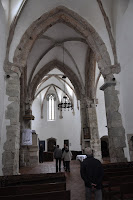We headed off to the South-east of the Barsa County fairly early so as to visit the most spectacular church of the region - Prejmer, now on the UNESCO' s world heritage list. I was once more impressed by the extensive arable fields all the way there.

According to historical accounts at the beginning of the fifteenth century King Sigismund fearing the ever increasing danger of the Ottoman Turk invasion is said to have ordered the erection of strongly fortified defense systems in the county.
The building of the fortress in Prejmer began in 1427, when the region inhabitants surrounded their church with strong defense walls capable to give refuge to the entire community in times of war.
The fortress is ring-shaped with the enclosure wall provided on its entire length with loops equipped with shutters. Inside the main precincts, alongside the main walls unfold approximately 275 abodes and supply-store cells with stairways, balconies and wooden galleries, which could be used by the inhabitants of the village. Each household had its own cell, with separate entrance, a window and a sign with a number.The community could resume its everyday life her until the threat passed. There is even evidence of the fact that during the siege teaching was not interrupted, as there are two spacious rooms called "The old school".
We walked up and down the galleries exploring the various stairways and galleries and I must confess that the whole ensemble impressed me, though I was particularly happy when I walked out in the open, as some of the galleries were rather sinister.






The building of the church, situated inside the fortress and in the shape of a Greek cross was begun by the Teutonic knights. Once they were banished from those lands in 1225, the erection was continued in the early Gothic style by the Cistercian monks, to whom the Hungarian King Bela de 4th allowed four localities in the Barsa County, Prejmer being one of those.
The crossing and choir has splendidly worn stonework, while the nave has late Gothic vaulting. Worth of being noted was the gothic polypthyc sanctuary depicting five scenes on its front. The central panel depicting the Crucification of Jesus and the side images representing the Complaint of Jesus, The Resurrection, the Descent into the grave and the Sanctimonious women at the grave.


We still had time to visit a small Museum within the walls, which exhibited a few fine examples of Saxon Costumes, which I quite liked.
As we walked out we were approached by two young gipsy beggars, the first we came across throughout the circuit, but they were in no way nasty, though they followed us all the way to the bus.








Romania is very beautiful! You became very well in photos.
ReplyDeleteBELL